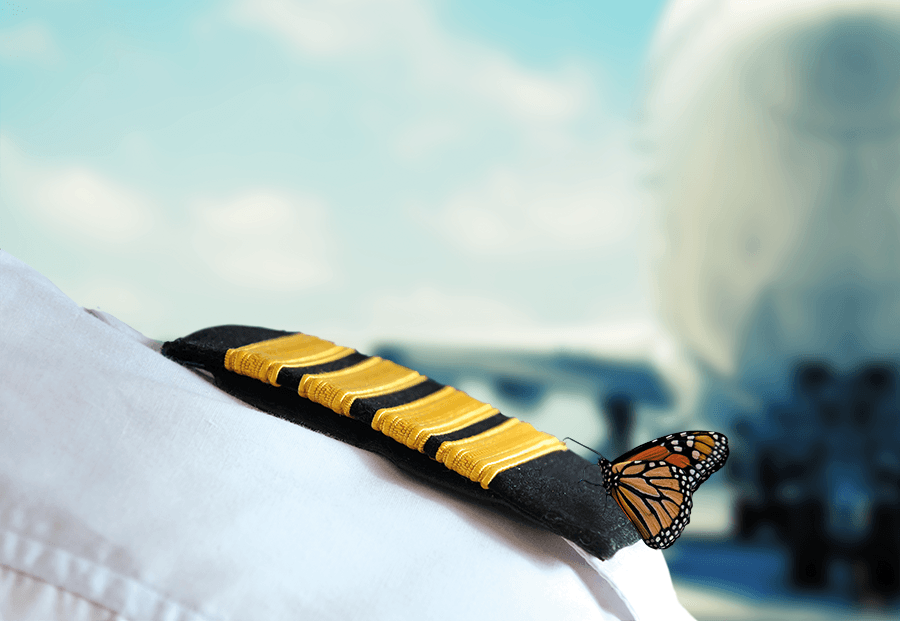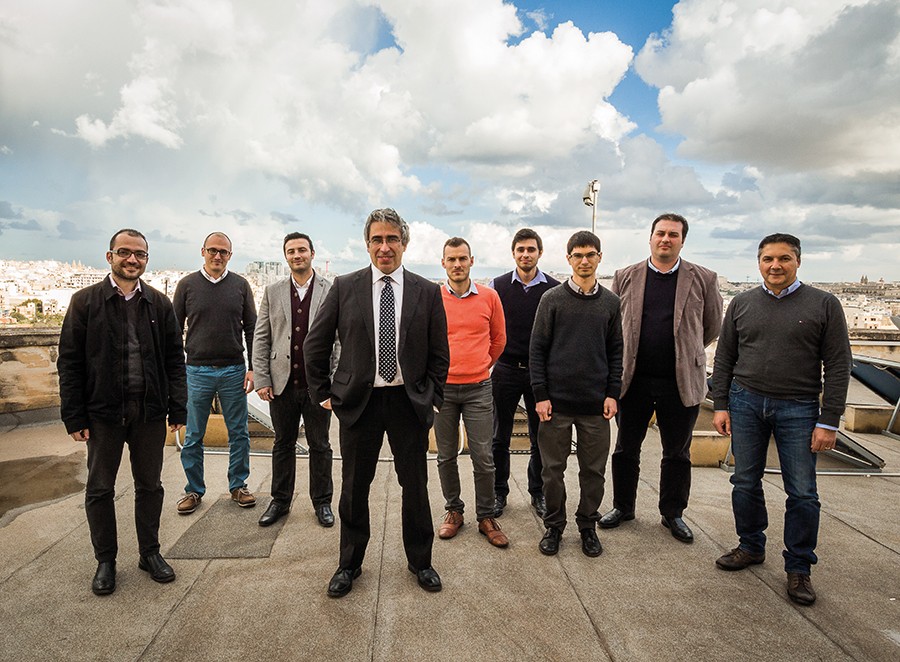Prof. Ing. David Zammit Mangion has been spearheading research in aviation at the University of Malta for two decades. With a focus on improving fuel burn, reducing emissions, and better flight management systems for pilots, the one overarching aim is safer air travel.
Last year the global fuel bill stood at €127 billion. It was responsible for nearly a fifth of the airline industry’s total operating costs of €740 billion. And that was a good year. Only three years earlier, the price of crude oil stood at over $100 a barrel, meaning the fuel bill was nearly double that of 2016, while other costs remained stable. With these sobering numbers, it comes as no surprise that aircraft manufacturers and airlines are seeking to improve fuel efficiency.
Commercial aircraft burn fossil fuels, generating man-made greenhouse gases. While the aviation industry contributes only a modest 2% to the global figure, it is one of the most rapidly growing contributors. As a result, industry leaders worldwide have been driving legislation, technology, and research to reduce the impact of air travel on the environment. In 2006 the European Commission and the major European aviation manufacturers created a €1.6 billion Joint Technology Initiative called Clean Sky to address the challenge. The resulting activities take place throughout the lifecycle of an aircraft, from reducing waste at the manufacturing stage, to operating the aircraft in a greener manner, to recycling of materials. The University of Malta (UoM) was one of the project partners involved from the very beginning, and it worked on the development of an optimisation tool. This software was then used by partners to identify a more environmentally friendly manner of flying.
Commercial planes fly from one airport to another through set paths, avoiding military airspace or no-fly zones. These routes may not be the fastest or shortest way of getting from point A to B, and optimising them is no trivial matter. Complications include adhering to the desired duration of flight, bad weather, wind variations, and the presence of other traffic in the vicinity. The scope of optimisation is to find the best way around these complications with minimal impact on operational cost and the environment. From a technical perspective, the question of optimisation is always the same: how many of the known factors should be taken into consideration? One extreme would result in a highly complex and computationally demanding task that may take several days to solve. The other would provide a quick result which would likely be way off the mark. The answer lies in finding what one can get away with.
“Our work saw us developing and proposing new routes in and out of Malta International Airport to allow for lower noise disturbance”
In Clean Sky, our task focused on theoretical studies, more specifically ground-based studies on how best to fly the airplane in complex operational conditions such as flying from Heathrow to Malta with typical traffic, and weather that represents real conditions. This meant we were hard on the complex side of the scale. The partners developed many detailed software models of the airplane, its engines, the operational environment, and airline business models together. We also had to develop state-of-the-art computational techniques for fast and accurate optimisation and a software framework that allows the user to integrate the different components in order to to run the software tool to carry out theoretical studies. At UoM, we were primarily involved with the design and development of the integration framework and software quality management. Using the tool, we then participated in the optimisation studies on flights to reduce noise, emissions, and fuel burn.
The Clean Sky experience afforded the UoM, its students, and staff an excellent opportunity in terms of funded, collaborative industrial research. Through the project, the University strengthened its established ties with European partners and built new ones. It offered opportunities for academics and research officers to work in a European collaborative environment, which is always exciting and extends our horizons. Clean Sky has also led to further initiatives, diverting the experience we gained in the project to address challenges that are related to the same theme.

It was Clean Sky that led to Malta Air Traffic Services (MATS) CEO, then full time academic, Kenneth Chircop’s doctoral research studies. In his research, Kenneth addressed the challenge of fast optimisation to allow trajectories to be altered optimally during flight. Planes are highly computerised, with a Flight Management System (FMS), managing the entire flight from take-off to landing. This system calculates runway distances, climb and descent profiles, fuel burn, time of flight, and so forth. However, its computational capacity to perform optimisation of trajectories is limited. A plane’s computer rarely has the latest technology, primarily due to safety and industrial requirements. In fact, computers on board an aircraft would be considered obsolete by most. These hardware limitations ‘force’ software programs to be relatively simple from a computational perspective, and this poses a challenge when attempting to perform multi-parameter trajectory optimisation within FMSs.
Kenneth developed a new technique that allows just this—with the calculation of an optimal trajectory in a complex operational environment being executed in only a matter of a few minutes. Some ‘thinking out of the box’ was required. He started by studying closely the behaviour of aircraft in complex operational conditions as if they were free to fly optimally and unhindered. We then put in constraints and found that aircraft tended to adopt strategies for particular conditions to achieve the most efficient flight path. We went on to characterise these strategies carefully and applied that knowledge to identify how the aircraft should fly in any new, given environment. This breakthrough approach allowed us to achieve our target of generating a result that is just as accurate as the most complex of optimisations within a fraction of the time it would normally take and, therefore, applicable to FMSs. It also led to Kenneth receiving the RTCA’s prestigious William E. Jackson Award.
However, the value of trajectory optimisation is not restricted to the flight deck. Nor is it complete without further consideration of other aircraft in the vicinity. Air traffic controllers have a more holistic view of air traffic needs, being responsible for separation between aircraft and for routing aircraft along their way. In this context, it is important to first establish efficient routing schemes. Our work, funded by the MCST National R&I Programme under the CLEAN FLIGHT project and led by Kenneth, saw us developing and proposing new routes in and out of Malta International Airport to allow for lower noise disturbance to the local population as well as less fuel burn and lower emissions. These proposals have already been used by MATS in their work to introduce new and sophisticated approach and departure procedures.
“Aircraft are very efficient aerodynamically and struggle to descend to earth steeply, even under no power.”
Under CLEAN FLIGHT, we also developed a tool to allow air traffic controllers to identify optimal trajectories that aircraft can fly along the published routes. This tool, again built on technology we developed, gives the air traffic controller a clear picture of how exactly an aircraft will be expected to fly optimally and, crucially, provides a look into the future to provide confidence that the aircraft will indeed remain clear of all other traffic as planned. This is a key function of value to air traffic controllers as it will allow them to confidently issue aircraft with clearance instructions in excess of thirty minutes in advance, a practice that is currently difficult to carry out whenever traffic is expected to converge simultaneously towards a waypoint or airport.
The results of CLEAN FLIGHT were very promising from an industrial perspective and led us to a second project, in which we are preparing to put the technology of CLEAN FLIGHT into in-trial operation and to extend the optimisation function to consider even more complex operational situations. The in-trial operations are exciting from a research perspective, as we are preparing to put the technology into industrial use with real aircraft, pilots, and air traffic controllers in a real air traffic control environment.
But our efforts in flight management do not stop there. Aircraft are very efficient aerodynamically and, perhaps contrary to common belief, struggle to descend to earth steeply, even under no power. Since it is more efficient for jet aircraft to fly at high altitude, they are typically flown at the preferred cruise altitude, ideally starting descent at the latest moment to just let the aircraft glide down to the airfield. The descent profile, however, depends on several constraints, including weather, terrain, traffic, and winds, and it is quite possible for several constraints to conspire and result in the aircraft approaching the airfield too high. This poses a safety threat, as a continued approach may, in severe cases, result in an unsafe landing attempt. Consequently, what is called ‘energy management’ is today considered important in the descent towards an airfield. So now the focus is generally on the development of tools that can provide confidence, from as early as top of descent, that the energy state of an aircraft on landing will be as desired. We added value to this by working on solving the issue of accurately identifying what needs to be done for the pilot to recover from a potentially unsafe condition with excessive energy.

As part of his PhD studies, colleague academic Brian Zammit developed a tool that helps pilots recover from an inadvertent deviation from the desired path. It identifies in three dimensions a new path that the aircraft will need to follow to arrive at the final approach point, at the correct height and speed, and at the right time. This, again, involves trajectory optimisation and, given the variables and uncertainties of the atmosphere, is technologically challenging to achieve with the desired accuracy. Our work has resulted in the development of a software prototype that is still on-going to allow us to improve the combination of accuracy and fast execution speed.
As our contributions to technology have a potential value to industry, the University has, through the Knowledge Transfer Office, taken the necessary steps to protect and exploit the intellectual property generated through our activities. We have been granted a patent in the United States for the invention of the ATC tool, and our other inventions have applications pending grant. Our next ambition is to continue transferring these and other technologies for use in the industry to further strengthen the contribution the University already provides to society, and to enjoy the work in the process.





Comments are closed for this article!